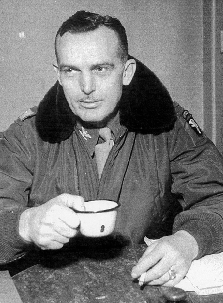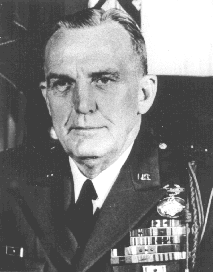
LT. COLONEL ROBERT F. SINK
Robert Frederich Sink was born in Lexington, North Carolina in April 3, 1905. Robert Sink studied at West Point, New York where he left graduate in June 14, 1927.
His first assignment as a Second Lieutenant was with the 8th Infantry at Fort Screven, Georgia. In November 1929, he was assigned to the 65th Infantry in San Juan, Puerto Rico. In March 1932, he joined the 34th Infantry at Fort Meade, Maryland. He remained there until July 1933, when he was assigned to the Civilian Conservation Corps at Fort McAlevy, Pennsylvania until December. He was back to the 34th Infantry.
After short studies at the Infantry school at Fort Benning in September 1934, he was assigned to the 57th Infantry at Fort McKinley in the Filipino islands. He went back to the United States in November 1937 and was assigned to the 25th Infantry at Fort Huachuca, Arizona where he successively served as a company commander then as an operation officer for a regiment.
Sink met the airborne troops for the 1st time in November 1940 when he was affected to the 501st Parachute Infantry Battalion in Fort Benning. Later, he took on the 503rd Parachute Infantry Battalion and the 503rd Parachute Infantry Regiment. In July 1942, he was called as the commander of the 506th Parachute Infantry Regiment in Toccoa, Georgia and at Fort Benning also in Georgia and then at Fort Bragg, North Carolina.
In September 1943, the 506th PIR was sent to Europe. Robert Sink remained with the command of the regiment during the whole war through with the rank of Lieutenant Colonel.In August 12, 1945, Sink was named as the auxiliary commander of the 101st Airborne with the rank of General Sergeant.
In December 1945, General Sink went back to the United States. The following month he assumed the direction of the draft of the infantry of the United States Military Academy. In August 1948, he joined the National War College of Washington DC. He left graduate in June 1949.
General Sink was transferred at Ruckus Command and was named Chief of staff in October 1949. In January 1951, he was named commander assistant for the 7th Infantry Division in Korea.
He went back to the United States to be the commander assistant for the 11th Airborne at Fort Campbell, Kentucky in December 1951. In February 1953, he assumed the command of the 7th Armored Division at Camp Roberts, California.
In November 1953, he assumed the command of the 44th Infantry Division at Fort Lewis,Washington.
In October 1954, General Sink was assigned to the Joint Airborne Troop at Fort Bragg, North Carolina. At the beginning of 1955, he was sent to Rio de Janeiro, Brazil, and in April 1955 assumed the duties of the President of the delegation for the United-States for the military co-operation but also as a consultant for the group of the military aid.
He went back to the United States in May 1957 to assume the command of the XVIII Airborne Corps at Fort Bragg.
In May 1958, he was promoted to the rank of commander of the Strategic Army Corps.
His last assignment was the command of the American forces in Panama.
Lieutenant General Robert F. Sink retired in 1961. He died on December 13, 1965. He left a widow and 3 children.
 <- Robert Sink with the rank of General.
<- Robert Sink with the rank of General.
List received decorations and quotations:
Silver Star with two oak leaf clusters
Legion of Merit with one oak leaf cluster
Air Madal with one oak leaf cluster
Distinguished Unit Citation with one oak leaf cluster
American Defense Service Medal
American Campaign Medal
Occupation of
Combat Infantry Badge
Occupation of
Korean Service Medal
Korean Presidential Citation
Decorations European:
Belgium:
Croix de Guerre avec Palme
Fourragère
Ordre de Léopold, grade d’officier avec palme
France :
Croix de Guerre avec Palme
Lanière Orange
Bronze Lion Decree
Distinguished Service Order
The Sink General was also Jump Master and took part in two jumps
of combat in